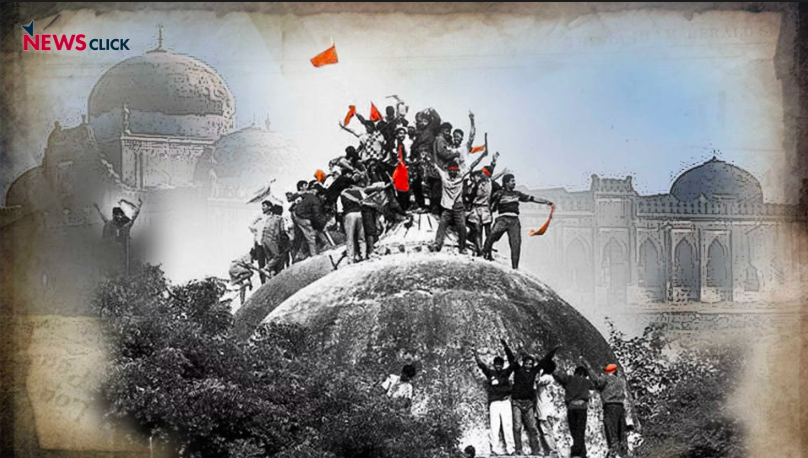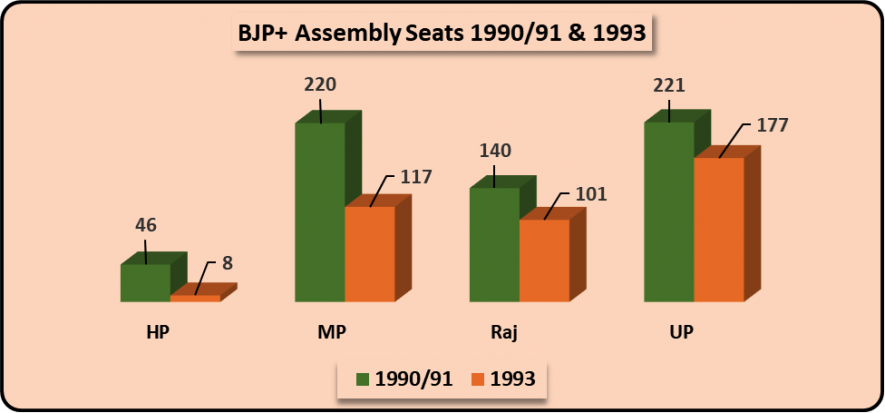Ram Temple: Reviving a Ghost, Because Elections Are Here

The events are eerily similar – the same assemblies of saints and seers, the same saffron flags and headbands, the same slogans, the same dramatis personae. That was in the violent years of 1989 to 1992 which left India scarred and bleeding. This is nearly three decades later, as thousands of saffron activists descend upon Ayodhya this weekend to “start the construction of Ram Temple”.
On Saturday, Shiv Sena supremo Uddhav Thackeray flew in on a charted flight to conduct puja on the banks of Saryu river in Ayodhya and issue a warning to the ‘sleeping’ BJP govt. that the Temple comes before the Govt. An estimated 7000 Shiv Sainiks are arriving with him, though by train. Flustered by this aggressive stance of its long-term ally, the Sangh Parivar has called for a Dharm Sansad or religious parliament in Ayodhya on Sunday supposed to be attended by a galaxy of saints and seers and several thousand activists. RSS has openly supported this meet, promising to mobilise its swayamsevaks in full strength. UP chief minister Yogi Adityanath is supporting the whole jamboree and BJP MLAs and ministers are working round the clock to make arrangements.
Flashback to 1992: a similar Dharm Sansad was held in late October resolved to build a Temple where the Babri Masjid stood. Some 70,000 karsevaks (voluntary workers) were mobilised on the fateful day, Dec 6, led by 500 saints and seers, and prominent BJP leaders like LK Advani, MM Joshi, Uma Bharti etc. By afternoon, despite heavy security forces deployment, and despite a sworn affidavit by the UP chief minister, BJP’s Kalyan Singh given to Supreme Court, that no damage will be allowed, the mosque was razed to the ground and a makeshift Ram temple constructed.
In the build up to this brazen act of lawlessness, that too by a major political party, thousands had lost their lives in communal riots as first Ram Shila Pujan (consecration of bricks for the temple) programme and then Advani’s infamous Rath Yatra (chariot tour) criss-crossed the country sowing seeds of hatred and animosity. Even the 1989 elections turned into one of the bloodiest on record.
Planned Build-Up of Temple Issue
Here’s a curious fact: every Dusshehra day, also called Vijayadashmi, the RSS supremo delivers an address that reviews the current political and social situation and lays down a framework on which the RSS has to act in the coming months. After Modi came to power in May 2014, Mohan Bhagwat has delivered five addresses. In the first four, 2014, 2015, 2016 and 2017, he talked about everything from Pakistan to Rohingya refugees to corruption and economic ills, and of course, the work of Modi govt. But he never uttered one word about the Ram Temple. But come 2018 Vijayadashmi (26 October) and he vociferously demanded that the Hindu Nation demands the speedy building of this Temple in Ayodhya.
What made him remain quiet for four years and suddenly wake up to the Ram Temple demand now? There is only one answer: in a few months, elections are going to be held and the RSS chief was ordering that the Sangh Parivar must reignite the demand so that the Hindus of India can be mobilised to vote for the Modi led BJP once again.
A few weeks earlier, the Vishwa Hindu Parishad (VHP) had held a meeting in New Delhi (on October 5) reiterating the demand. The meeting, according to reports, was rather dismal with many saints and seers not turning up. But, with the RSS supremo throwing his weight behind the demand, things got moving.
A splinter of the VHP, led by Praveen Togadia, held a small but much hyped demonstration in Ayodhya, demanding building of the Temple. Meanwhile the RSS floated a new outfit called Shri Ram Mandir Nirman Sahayog Manch to catalyse the reinvention of the movement.
Meanwhile, on October 29, a three-judge bench of the Supreme Court postponed the hearings on the Ayodhya land title suit and other cases till January. This caused a ripple to spread in the Hindu fundamentalist world because it meant that no relief was forthcoming from the Court in the near future.
Then, on 3-4 November, a two-day meet in Delhi of saints and seers under the aegis of the Akhil Bharatiya Sant Samiti called for an ordinance or law to build the Ram Temple in Ayodhya. It also stressed that people in India should ensure that the Modi government wins in 2019. A dharmadesh (religious order, like a fatwa) said that people should vote for those who have faith in “Gau, Ganga, Geeta, Gayatri and Govind”. In other words, straight from the top of the Hindu religious authority (if such a thing exists) came the connection between the Ram Temple and the re-election campaign of the BJP.
Finally, the call came for a congregation in Ayodhya on 25 November where the building of Ram Temple would be initiated.
Can Ram Revive Sinking BJP?
If the BJP and the wider Sangh Parivar is thinking that the revival of the Ram Temple movement will save its skin in the forthcoming elections then it is not just a dangerous game they are playing but also a very risky one. The danger is for the whole country because any revival of the movement would mean a repetition of the violence that swept through the country earlier. For the Sangh Parivar, this may not matter much but for the people it is a fraught scenario.
The risk in reviving the movement is for the BJP itself. Here’s why.
Another curious fact: after the Babri Masjid was destroyed on December 6, 1992, four BJP led state govts. were dismissed because they had openly assisted in the illegal act. They were the govts. of UP, MP, Rajasthan and HP. After a year under President’s Rule, these four states went to polls in December 1993. And, BJP lost all four states. (See Chart below)

The rising trajectory of BJP through the 1980s was abruptly cut short because people in the Northern states were sick and tired – horrified – by the continuing violence and poison spewing that had destroyed livelihoods and disrupted normal social life. It took several years of back-pedalling for BJP to win these states back.
Even the NDA rule of 1998-2004 under Vajpayee did not see much traction to the Ram Temple movement although the litigation continued and RSS propaganda too carried on. But the people had seen through the Temple-Election game of the BJP and it was only when BJP talked of ‘development’ or corruption etc. that they could garner support.
Three decades down the line, the people are much wiser to this brazenly opportunist gambit of raising the Temple issue as elections approach. They know that it is all chest thumping and theatre. Modi is going to be judged for his performance and delivery on his promises – like jobs, end of corruption and black money, prosperity and achche din. No amount of Temple building rhetoric or even sabre-rattling is going to win any substantial votes for him.
Get the latest reports & analysis with people's perspective on Protests, movements & deep analytical videos, discussions of the current affairs in your Telegram app. Subscribe to NewsClick's Telegram channel & get Real-Time updates on stories, as they get published on our website.























